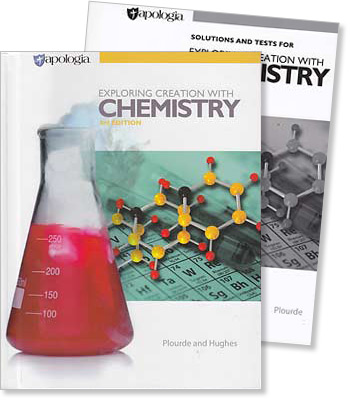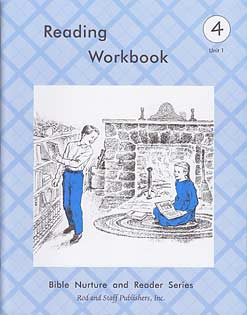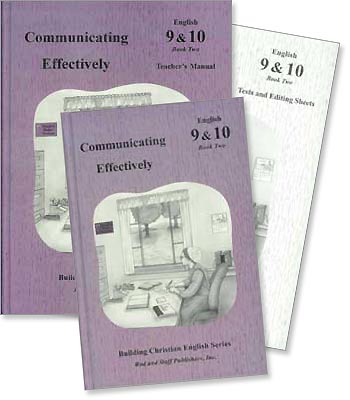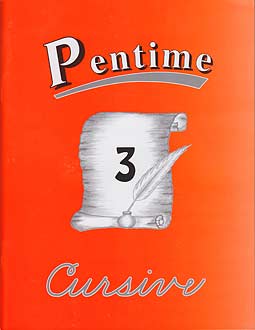
Grade 10 Apologia Chemistry [3rd Ed] Set
- 7.74 lbs
Item #52-10--
| This set includes: | # in My Cart | ||
|---|---|---|---|
| Pupil Textbook | $89.00 | ||
| Solutions and Tests Manual | $27.00 | ||
| This set includes: 2 items (set discount: 5.3%) | -$6.10 | ||
This course provides a rigorous foundation in chemistry in order to prepare your student for college-level studies. We recommend that students taking this course be proficient at an algebra math level. Topics include significant figures, units, classification, the mole concept, stoichiometry, thermochemistry, thermodynamics, kinetics, acids and bases, redox reactions, solutions, atomic structure, Lewis structures, molecular geometry, gas laws, and equilibrium.
This revised edition offers more in-depth discussions and explanations of concepts, as well as biographical sketches of Christian scientists who've made a difference in the field while giving the glory to God. Experiments include measuring specific heat, discovering the electrical conductivity of compounds dissolved in water, measuring the width of a molecule, exploring freezing point depression, using the ideal gas equation, recognizing the effects of catalysts, and much more. While the lab experiments in this course are designed for the home, some of them are more easily performed using specialized equipment available from Apologia.
- Complete List of Lab Supplies
Table of Contents
MODULE 1: MEASUREMENT, UNITS, AND THE SCIENTIFIC METHOD
- Experiment 1.1: Determining If Air Has Mass
- Experiment 1.2: Determining If Air Takes Up Space
- Units of Measurement
- The Metric System
- Manipulating Units
- Converting between Units
- Converting between Unit Systems
- More Complex Unit Conversions and Problem Solving
- Derived Units
- Making Measurements
- Accuracy, Precision, and Significant Figures
- Scientific Notation
- Using Significant Figures in Mathematical Problems
- Experiment 1.3: Comparing Conversions to Measurements
- Measuring Temperature
- The Nature of a Scientific Law
- Experimentation and the Scientific Method
- Summary of Key Equations and Tables
- Answers to the “On Your Own” Questions
- Study Guide: Review Questions
- Study Guide: Practice Problems
MODULE 2: ATOMS AND MOLECULES
- Early Attempts to Understand Matter
- The Law of Mass Conservation
- Experiment 2.1: Conservation of Mass
- Elements: The Basic Building Blocks of Matter
- Compounds
- The Law of Multiple Proportions
- Dalton’s Atomic Theory
- Molecules: The Basic Building Blocks of Compounds
- Abbreviating and Classifying Compounds
- Classifying Matter as Ionic or Covalent
- Experiment 2.2: Electrical Conductivity
- of Compounds Dissolved in Water
- Naming Compounds
- Classifying Matter
- Experiment 2.3: Separating a Mixture of Sand and Salt
- Summary of Tables
- Answers to the “On Your Own” Questions
- Study Guide: Review Questions
- Study Guide: Practice Problems
MODULE 3: ATOMIC STRUCTURE
- Historical Overview
- Electrical Charge
- Experiment 3.1: Investigating Electrical Charge
- Electrical Charge and Atomic Structure
- Determining the Number of Protons and Electrons in an Atom
- Determining the Number of Neutrons in an Atom
- Isotopes and Nuclear Bombs
- Atomic Structure in More Detail
- The Nature of Light
- The Electromagnetic Spectrum
- The Relationship between Frequency and Energy
- How the Eye Detects Color
- Experiment 3.2: How Our Eyes Detect Color
- The Bohr Model of the Atom
- The Quantum Mechanical Model of the Atom
- Building Atoms in the Quantum Mechanical Model
- (Electron Configurations)
- Abbreviated Electron Configurations
- The Amazing Design of Atoms
- Summary of Key Equations
- Answers to the “On Your Own” Questions
- Study Guide: Review Questions
- Study Guide: Practice Problems
MODULE 4: MOLECULAR STRUCTURE
- Electron Configurations and the Periodic Table
- Lewis Structures
- Lewis Structures for Ionic Compounds
- Handling the Exceptions in Ionic Compounds
- Ionization Energy and Periodic Properties
- Electronegativity: Another Periodic Property
- Atomic Radius: Another Periodic Property
- Lewis Structures of Covalent Compounds
- More Complicated Lewis Structures
- An Application of Lewis Structures
- Summary of Tables
- Answers to the “On Your Own” Questions
- Study Guide: Review Questions
- Study Guide: Practice Problems
MODULE 5: POLYATOMIC IONS AND MOLECULAR GEOMETRY
- Polyatomic Ions
- Molecular Geometry: The VSEPR Theory
- Nonpolar Covalent and Polar Covalent Bonds
- Experiment 5.1: Comparing Polar Covalent
- and Nonpolar Covalent Compounds
- Nonpolar Covalent and Polar Covalent Molecules
- The Practical Consequence of Whether or Not
- a Molecule Is Polar Covalent
- Experiment 5.2: Comparing Solubility of Ionic Compounds
- in Polar Covalent and Nonpolar Covalent Compounds
- Summary of Tables
- Answers to the “On Your Own” Questions
- Study Guide: Review Questions
- Study Guide: Practice Problems
MODULE 6: CHANGES IN MATTER AND CHEMICAL REACTIONS
- Classifying Changes That Occur in Matter
- Experiment 6.1: Distinguishing between
- Chemical and Physical Change
- Phase Changes
- Experiment 6.2: Condensing Steam
- The Kinetic Theory of Matter
- Experiment 6.3: The Relation between the
- Speed and Temperature of Molecules
- Density
- Experiment 6.4: Comparing the Density of Liquids
- Phase Changes in Water
- Chemical Reactions and Chemical Equations
- Determining Whether or Not a Chemical Equation
- Is Balanced
- Balancing Chemical Equations
- Summary of Key Equations and Tables
- Answers to the “On Your Own” Questions
- Study Guide: Review Questions
- Study Guide: Practice Problems
MODULE 7: DESCRIBING CHEMICAL REACTIONS
- Three Basic Types of Chemical Reactions
- Decomposition Reactions
- Formation Reactions
- Combustion Reactions
- Combustion of Metals
- Complete Combustion Reactions
- Incomplete Combustion Reactions
- Atomic Mass
- Molecular Mass
- The Mole Concept
- Experiment 7.1: Measuring the Width of a Molecule
- Using the Mole Concept in Chemical Equations
- Summary of Key Equations and Tables
- Answers to the “On Your Own” Questions
- Study Guide: Review Questions
- Study Guide: Practice Problems
MODULE 8: STOICHIOMETRY
- Mole Relationships in Chemical Equations
- Limiting Reactants and Excess Components
- Experiment 8.1: Determining Which Reactant Is
- the Limiting Reactant
- Fully Analyzing Chemical Equations
- Relating Products to Reactants in Chemical Equations
- Using Chemical Equations When the Limiting
- Reactant Is Identified
- Volume Relationships for Gases in Chemical Equations
- Mass Relationships in Chemical Equations
- Using Stoichiometry to Determine Chemical Formulas
- Empirical and Molecular Formulas
- More Complicated Experiments for Determining
- Chemical Formulas
- Answers to the “On Your Own” Questions
- Study Guide: Review Questions
- Study Guide: Practice Problems
MODULE 9: ACID-BASE CHEMISTRY
- Acids and Bases
- Experiment 9.1: Common Household Examples
- of Acids and Bases
- The Chemical Definitions of Acids and Bases
- The Behavior of Ionic Compounds in Aqueous Solutions
- Identifying Acids and Bases in Chemical Reactions
- Recognizing Acids and Bases from Their
- Chemical Formulas
- Predicting the Reactions That Occur between
- Acids and Bases
- The Reactions between Acids and Covalent Bases
- Molarity
- The Dilution Equation
- The Importance of Concentration in Chemistry
- Using Concentration in Stoichiometry
- Acid-Base Titrations
- Experiment 9.2: Determining the Concentration
- of Ammonia
- Summary of Key Equations and Tables
- Answers to the “On Your Own” Questions
- Study Guide: Review Questions
- Study Guide: Practice Problems
MODULE 10: THE CHEMISTRY OF SOLUTIONS
- How Solutes Dissolve in Solvents
- Solubility
- Experiment 10.1: Determining the Effect of Temperature
- on the Solubility of Solid Solutes
- Experiment 10.2: Determining the Effect of Temperature
- on the Solubility of a Gas
- Energy Changes That Occur When Making a Solution
- Experiment 10.3: Investigating a Solute That Releases
- Heat When Dissolved
- Applying Stoichiometry to Solutions
- Molality
- Freezing-Point Depression
- Experiment 10.4: Measuring Freezing-Point Depression
- Boiling-Point Elevation
- Summary of Key Equations and Tables
- Answers to the “On Your Own” Questions
- Study Guide: Review Questions
- Study Guide: Practice Problems
MODULE 11: THE GAS PHASE
- The Definition of Pressure
- Boyle’s Law
- Charles’s Law
- The Combined Gas Law
- Ideal Gases
- Dalton’s Law of Partial Pressures
- Vapor Pressure
- An Alternative Statement of Dalton’s Law
- The Ideal Gas Law
- Experiment 11.1: Determining the Ideal Gas Constant
- Using the Ideal Gas Law in Stoichiometry
- Experiment 11.2: Using the Ideal Gas Equation
- to Determine the Amount of Acid in Vinegar
- Summary of Key Equations and Tables
- Answers to the “On Your Own” Questions
- Study Guide: Review Questions
- Study Guide: Practice Problems
MODULE 12: ENERGY, HEAT AND TEMPERATURE
- Energy and Heat
- The First Law of Thermodynamics
- Units for Measuring Heat and Energy
- Experiment 12.1: Thermometer Calibration and Confirmation
- of Boiling and Freezing Temperatures of Water
- The Calorie Unit
- Measuring Heat
- Calorimetry
- Experiment 12.2: Measuring the Specific Heat of a Metal
- Summary of Key Equations and Tables
- Answers to the “On Your Own” Questions
- Study Guide: Review Questions
- Study Guide: Practice Problems
MODULE 13: THERMODYNAMICS
- Enthalpy
- Determining ΔH for a Chemical Reaction by Experiment
- Experiment 13.1: Determining the ΔH of a Chemical Reaction
- Determining the ΔH of a Chemical Reaction
- Using Bond Energies
- Hess’s Law
- Applying Enthalpy to Stoichiometry
- Energy Diagrams
- The Second Law of Thermodynamics
- The Proper Application of the Second Law
- of Thermodynamics
- Gibbs Free Energy
- Summary of Key Equations and Tables
- Answers to the “On Your Own” Questions
- Study Guide: Review Questions
- Study Guide: Practice Problems
MODULE 14: KINETICS
- Reaction Kinetics
- Factors That Affect the Kinetics of a Chemical Reaction
- Experiment 14.1: How Concentration and
- Temperature Affect Chemical Reaction Rates
- The Rate Equation
- Using Experiments to Determine the Details
- of the Rate Equation
- Rate Orders
- Using Rate Equations
- Temperature Dependence in the Rate Equation
- Catalysts and Reaction Rate
- Experiment 14.2: The Effect of a Catalyst
- on the Decomposition of Hydrogen Peroxide
- Summary of Key Equations
- Answers to the “On Your Own” Questions
- Study Guide: Review Questions
- Study Guide: Practice Problems
MODULE 15: CHEMICAL EQUILIBRIUM
- The Definition of Chemical Equilibrium
- Experiment 15.1: A Demonstration of Equilibrium
- The Equilibrium Constant
- A Few More Details about the Equilibrium Constant
- Using the Equilibrium Constant to Predict
- the Progress of a Reaction
- Le Chatelier’s Principle
- Pressure and Le Chatelier’s Principle
- Temperature and Le Chatelier’s Principle
- Experiment 15.2: Temperature Effects
- on Reactions and Le Chatelier’s Principle
- Acid-Base Equilibria
- The pH Scale
- Acid Rain
- Summary of Key Equations
- Answers to the “On Your Own” Questions
- Study Guide: Review Questions
- Study Guide: Practice Problems
MODULE 16: REDUCTION-OXIDATION REACTIONS
- Oxidation Numbers
- Determining Oxidation Numbers
- Oxidation and Reduction
- Recognizing Reduction-Oxidation Reactions
- An Important Characteristic of Reduction-Oxidation
- Reactions
- Experiment 16.1: Demonstrating an Oxidation-Reduction
- Reaction
- How Batteries Work
- Experiment 16.2: Creating a Galvanic Cell from Lemons
- Real Batteries
- Corrosion
- Some Final Words
- Answers to the “On Your Own” Questions
- Study Guide: Review Questions
- Study Guide: Practice Problems
GLOSSARY
APPENDIXES
- Appendix A: Tables, Laws, and Equations
- Appendix B: Extra Practice Problems
- Appendix C: Complete List of Lab Supplies
REFERENCES
INDEX











